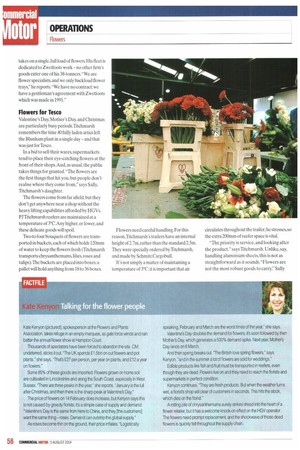Kate Kenyon (pictured), spokesperson at the Flowers and Plants Association,
Page 58

If you've noticed an error in this article please click here to report it so we can fix it.
takes refuge in an empty marquee, as gale force winds and rain batter the annual flower show at Hampton Court.
Thousands of spectators have been forced to abandon the site, CM, undeterred, sticks it out, 'The UK spends £1.5bn on cut flowers and pot plants," she says. 'That's £27 per person, per year on plants, and £12 a year on flowers,"
Some 85% of these goods are imported. Flowers grown on home soil are cultivated in Uncolnshire and along the South Coast, especially in West Sussex, 'There are three peaks in the year," she reports. "January is the lull after Christmas, and then there is the sharp peak at Valentine's Day."
The price of flowers on 14 February does increase, but Kenyon says this is not caused by greedy f brists; it's a simple case of supply and demand: "Valentine's Day is the same from here to China, and they [the customers] want the same thing roses. Demand can outstrip the global supply."
As roses become thin on the ground, their price inflates. "Logistically speaking, February and March are the worst times of the year,' she says
Valentine's Day doubles the demand for flowers; it's soon followed by then Mother's Day which generates a 500% demand spike. Next year, Mothers Day lands 0116 March, And then spring breaks out. 'The British love spring flowers," says Kenyon, "and in the summer a lot of flowers are sold for weddings."
Edible products like fish and fruit must be transported in reefers, even though they are dead. Flowers live on and they need to reach the florists and supermarkets in perfect condition.
Kenyon continues. "They are fresh products. But when the weather turns we a f brist's shop will clear of customers in seconds. This hits the stock, which dies on the florist."
A rotting pile of chrysanthemums surely strikes dread into the heart of a flower retailer, but it has a welcome knock-on effect on the HGV operator. The flowers need prompt replacement, and the shockwave of those dead flowers is quickly felt throughout the supply chain.


































































































































































































